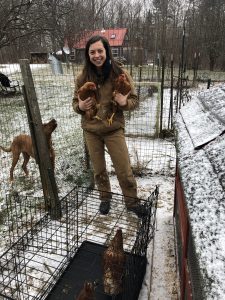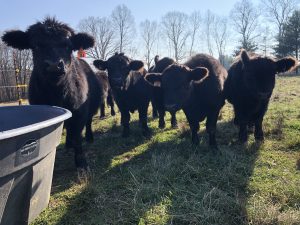Cows, Poetry, and Facing the Climate Crisis
Contact
The Words: Macalester's English Student NewsletterSenior Newsletter Editors:
Birdie Keller '25
Daniel Graham '26
Callisto Martinez '26
Jizelle Villegas '26
Associate Newsletter Editors:
Ahlaam Abdulwali '25
Beja Puškášová '26
Sarah Tachau '27
Peyton Williamson '27
by Malcolm Cooke ’21
Molly Sowash ’16 has recently started a newsletter. Some of the topics? Cows and the climate crisis. Her writing weaves the poetry and literary influences she developed getting her Creative Writing degree (and as a Senior Newsletter Editor for the Words!) at Macalester into promoting education on sustainable agriculture.
“It’s a lot more of sharing my story, writing my thoughts about the environmental crisis we’re in and what it means to work with the land,” Molly said. “A lot of inspiration I find from authors like Wendell Berry and Robin Wall Kimmerer. I definitely weave writing into that through that newsletter.”
Although the newsletter is a more personal project, Molly also employs writing in her AmeriCorps position at the NGO Rural Action. The organization works in Appalachian Ohio to develop communities both environmentally, socially, economically, and overall sustainably.
But utilizing writing and storytelling as a tool for education on sustainability isn’t anything new for Molly. Even before there was the Food, Agriculture, and Society concentration at Macalester, Molly took a number of food studies classes, which she funneled into her work with two different Twin Cities-based non-profits: Youth Farm and Midwest Food Connection.
At Youth Farm, Molly worked with young people on urban farms and in the kitchen. The focus was youth development using food as a tool. Meanwhile, at Midwest Food Connection, she taught in a more formal manner at public schools, where curriculum on food was greatly lacking. Storytelling was one of the methods of promoting active engagement from the students, which often created a fertile environment for growth and exploration.

“We used a lot of storytelling. For example one of our lessons was about wild rice and we told this Ojibwe story of its discovery and meanwhile, we’re cooking it and the kids are smelling it and there’s this whole like classroom environment that is built up,” Molly said. “There’s so much excitement through the storytelling and through the smells that eventually when it comes time to taste, the kids end up being a lot more courageous than they would be at home.”
This work was based in the Twin Cities, and while Molly loved it there, she still felt a continual pull home to Ohio. She has close ties to family there, which was a major reason for her return, as well as a connection to the environment itself.
“[I] grew up spending weekends out at my uncle’s farm, knowing the wildflowers and the humidity and the cicadas and the rhythm of the seasons that is just different in Minnesota,” Molly said.
Understanding these connections to family and the land, Molly once again looked to literature and poetry. Through this, literature paved the way for direct action.
“I intentionally read a lot of Wendell Berry’s stuff because I knew he would fortify me in my decision to go home,” Molly said. “He writes a lot about homecoming and the importance of people, especially people who go off to get a great education, coming home and using their skills and assets for their really immediate locale. I am compelled by the idea of thinking globally and acting locally and I’m kind of trying that out right now.”
Now, in addition to her work with AmeriCorps, Molly owns eight calves. In caring for them, her tenure at Moonstone farm and education on sustainable agriculture comes back into play, as a reminder of how the judicious caring of livestock can also play a role in overcoming the climate crisis.
For much of the history of the United States, before settler colonialism changed the nature of flora and fauna, the Great Plains were inhabited by roaming herds of Bison, which had a symbiotic relationship to their ecosystem. As the Bison grazed, they would trample their poop into the grasses, and then leave an already grazed area for sometimes as long as an entire year. It turns out that the combined process of agitating the grass through minor grazing and hooves and fertilization from manure made for robust grasslands which were excellent at sequestering carbon in the soil.

This ecological relationship is the theory behind a kind of livestock management that has a number of names, like holistic management, management intensive grazing, and mob grazing. This process of raising livestock removes more carbon from the atmosphere than it produces through gases like methane. And although growing crops like soybeans might feed more people, livestock can graze in locations that crops cannot grow.
“You can graze livestock in a lot of areas that are not conducive to growing crops,” Molly said. “I’m in southeast Ohio at the start of the Appalachian range and so we have really clayey soil, it’s hilly, it’s rocky, it’s not really that great of farming land but there’s so much potential for running livestock on it.”
As Molly says, farming is a long game. She won’t have beef to sell for another year, and won’t be able to see the organic matter rise in her soil tests for as many as five years. Because of this, she feels connected to the land. Even if farming doesn’t become her sole, full-time job, she has staked her claim here, even finally having enough space to get her first dog.
It is also the first time she’s lived permanently in a rural area and at first she was worried about loneliness. But then COVID hit, and was a great equalizer in terms of isolation, both rural and urban. Despite the uncertain future, Molly is glad to be where she is, understanding the connection she has to the land.
“Now that we’re in a pandemic and people are stuck at home I am so grateful to be living on a piece of land where I can get outside easily,” Molly said. “I’m checking on the cows every day. I think there’s a difference in being alone outside in nature where you don’t have anything around you and being alone surrounded by people and buildings. There’s just a different connection.”